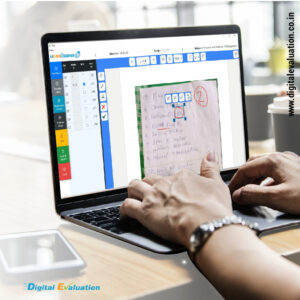
The digital revolution has swept through education, transforming the traditional classroom into a dynamic learning environment. One of the most impactful changes is the rise of digital assessments, where students take exams and complete assignments online.
While the benefits of digital assessments are numerous, the evaluation process itself can be a bottleneck. This is where on-screen marking comes in, offering a streamlined and efficient way for educators to provide feedback and students to receive valuable insights.
Here are five key ways on-screen marking enhances the digital assessment experience for both educators and students:

- Increased Efficiency and Streamlined Workflow:
On-screen marking eliminates the need for manual processes like paper distribution, collection, and physical grading. Educators can access all assessments electronically, allowing them to mark directly on the student’s digital work.
This saves valuable time and reduces administrative burdens, freeing up more time for educators to focus on providing quality feedback and individualized instruction.
- Enhanced Feedback and Improved Learning:
Digital assessments often provide a wider range of question formats, including interactive exercises and multimedia elements. On-screen marking tools allow educators to provide immediate and specific feedback directly on the student’s work.
This can include text annotations, audio comments, or embedded multimedia resources that offer a richer learning experience. Students can readily access and revisit the feedback, facilitating a deeper understanding of their strengths and weaknesses.
- Richer Data Analysis and Personalized Learning:
On-screen marking platforms capture detailed data on student performance, providing deeper insights into individual strengths and areas for improvement. Educators can analyze student responses across entire classes, identify common misconceptions, and tailor their teaching strategies to address specific learning needs.
This data-driven approach fosters personalized learning and allows educators to create targeted interventions for students who need additional support.
- Increased Transparency and Improved Communication:
On-screen marking tools often provide rubrics and marking schemes that are easily accessible to students. This transparency allows students to understand the criteria used for assessment and identify areas where they can improve future performance.
Additionally, some platforms offer features for two-way communication, enabling students to ask questions or clarify doubts about their feedback. Hence fostering a more interactive learning environment.
- Accessibility and Flexibility:
On-screen marking platforms can be accessed from anywhere with an internet connection, offering flexibility for both educators and students. This eliminates geographical limitations and allows for assessments to be completed remotely.
Additionally, many platforms offer accessibility features like text-to-speech conversion or screen-reading capabilities, catering to students with diverse learning needs.
The Future of Assessment:
On-screen marking is not simply a replacement for traditional methods; it represents a transformative shift towards a more efficient, insightful, and engaging assessment experience.
By leveraging the power of technology, on-screen marking empowers educators to provide timely feedback, personalize learning journeys, and ultimately enhance student outcomes.
As digital assessment continues to evolve, we can expect further innovations that refine on-screen marking capabilities, further revolutionizing the educational landscape.



